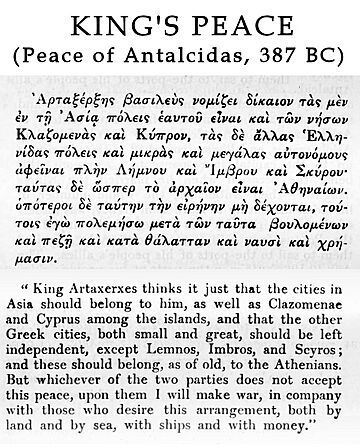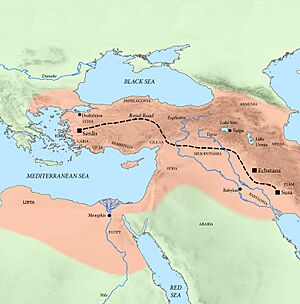Peace of Antalcidas facts for kids
The King's Peace was an important peace treaty in ancient Greece. It was signed in 387 BC and officially ended the Corinthian War. The powerful Persian King Artaxerxes II guaranteed this peace.
This treaty is also known as the Peace of Antalcidas. It's named after Antalcidas, a Spartan diplomat. He traveled all the way to Susa (in Persia) to talk with the Persian king and agree on the terms. People in ancient times often called it the King's Peace. This name shows how much influence the Persian Empire had over the Greek states at that time.
How the War Ended
By 387 BC, the main fighting in the Corinthian War had moved. It was no longer just on the Greek mainland. Instead, it was happening in the Aegean Sea. An Athenian fleet, led by Thrasybulus, had taken control of several cities in the Aegean. They were also working with Evagoras I, the king of Cyprus.
Evagoras was an enemy of Persia. Also, Athens' new gains threatened Persia's interests. Because of this, King Artaxerxes II changed his mind. He stopped supporting Athens and its friends. Instead, he decided to support Sparta.
Antalcidas, a Spartan commander, was called to Susa. He went with Tiribazus, a Persian governor (called a satrap). There, the Spartans and Persians worked out a plan to end the war.
To make Athens agree to talk, Antalcidas moved his fleet of 90 ships. He sailed them to the Hellespont. This was a very important sea route. It was where Athens got its grain (food) from the Black Sea region. The Athenians remembered their terrible defeat in 404 BC. Back then, Sparta had controlled the Hellespont. So, they agreed to negotiate this time.
Other Greek cities like Thebes, Corinth, and Argos also had to agree. They didn't want to keep fighting without Athens. Finally, all the fighting groups met at a peace conference in Sparta. Everyone agreed to the terms that King Artaxerxes had set.
What the Peace Treaty Said

The most important part of the King's Peace was how much Persian influence it showed. The Persian king's official statement, written down by the historian Xenophon, makes this very clear:
King Artaxerxes believes it is fair that the cities in Asia should belong to him. This includes Clazomenae and Cyprus among the islands. All other Greek cities, big and small, should be left independent [αὐτονόμους]. The only exceptions are Lemnos, Imbros, and Scyros. These islands should belong to the Athenians, as they always have. If either side does not accept this peace, I will make war on them. I will do this with those who want this agreement, both on land and at sea, with ships and with money.
This meant that the Greek cities in Ionia (part of modern-day Turkey) and the island of Cyprus now belonged to the Persians. Athens also had to give up the new lands it had won in the Aegean Sea.
Another big part of the treaty was the idea of "autonomy." This meant that each Greek city should be independent. This put an end to a new political idea that had started during the war. This was the union of Argos and Corinth. They had merged their governments, giving all citizens joint citizenship. The King's Peace forced them to separate. Thebes also had to break up its Boeotian league.
Only Sparta's Peloponnesian League and its enslaved people (called helots) were ignored. Sparta was in charge of making sure the peace was followed. They didn't want the rule of independence to apply to their own system.
Impact of the Peace
The biggest result of the King's Peace was that Persia got strong control over Ionia and parts of the Aegean Sea again. The Persians had been pushed back from the Aegean by the Delian League in the 400s BC. But they had been slowly gaining power since the end of the Peloponnesian War (431-404 BC). Now, they were strong enough to tell the Greeks what to do. Persia kept this strong position until the time of Alexander the Great (336-323 BC).
As historian Mikhail Gasparov said, "Artaxerxes had succeeded where Xerxes I had failed." This means the Persian King was giving orders in Greece as if it were his own land. And he did it without sending a single soldier! In short, the treaty put Greece under Persian control.
Another effect of this peace was that Sparta became very powerful. It was now at the top of the Greek political system, backed by the Persian King. Sparta used its power to protect the peace. But it also started campaigns against cities it saw as threats.
For example, they forced the city of Mantinea to break up into smaller villages. A bigger action was in 382 BC. Sparta tried to break up the Chalcidian League in northeastern Greece. They said this league went against the rule of autonomy. On their way there, in 383 BC, a Spartan commander named Phoebidas took over the Cadmeia (the main fort) in Thebes. He left a pro-Spartan government there, supported by Spartan soldiers. Even people who liked Sparta thought this was a crazy act. The idea of "autonomy" became a tool for powerful states to use as they wished.
The King's Peace did not bring lasting peace to Greece. Pelopidas and his friends freed Thebes in 379 BC. They did this by killing the pro-Spartan leaders. After Sparta's campaign against Olynthus (382-379 BC), fighting started again. This was the Boeotian War (378-371 BC). It continued, with short breaks, for almost two decades.
The idea of a "Common Peace" (a peace for all Greeks) was still important. Many attempts were made to create one, but they didn't have much more success than the original. By giving Sparta so much power, the treaty actually caused more problems. It made other states angry. So, constant warfare continued to be normal in Greece.
See also
- List of treaties




